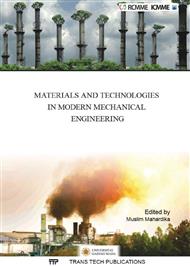[1]
S. Shafiee, E. Topal, When will fossil fuel reserves be diminished? Energy Policy (2009) 181-189.
DOI: 10.1016/j.enpol.2008.08.016
Google Scholar
[2]
N. Lopattananon, Y. Payae, M. Seadan, Influence of fiber modification on interfacial adhesion and mechanical properties of pineapple leaf fiber-epoxy composites, Journal of Applied Polymer Science 110 (2008) 433-443.
DOI: 10.1002/app.28496
Google Scholar
[3]
Jamasri, The Prospects of natural fiber composites development in Indonesia, Inauguration speech of Professor in the Faculty of Engineering, Gadjah Mada University, Yogyakarta, Indonesia, (2008).
DOI: 10.21742/ijswpm.2020.7.2.01
Google Scholar
[4]
K. Mohanty, M. Misra, G. Hinrichsen. Biofibres, biodegradable polymers and biocomposites: an overview, Macromol Mater Eng 276/277 (2000) 1–24.
DOI: 10.1002/(sici)1439-2054(20000301)276:1<1::aid-mame1>3.0.co;2-w
Google Scholar
[5]
S.N. Monteiro, L.P.D. Lopes, A.S. Ferreira, D.C.O. Nascimento, Natural-fiber polymer–matrix composites: cheaper, tougher, and environmentally friendly, JOM 61: 1 (2009) 17–22.
DOI: 10.1007/s11837-009-0004-z
Google Scholar
[6]
K.G. Satyanarayana, G.G.C. Arizaga, F. Wypych, Biodegradable composites based on lignocellulosic fibers – an overview, Prog Polym Sci 34: 9 (2009) 982–1021.
DOI: 10.1016/j.progpolymsci.2008.12.002
Google Scholar
[7]
M.J. John, R.D. Anandjiwala, Recent development in chemical modification and characterization of natural fiber-reinforced composites, Polym Compos 29: 2 (2008) 187–207.
DOI: 10.1002/pc.20461
Google Scholar
[8]
M.M. Rahman, M.A. Khan, Surface treatment of coir (Cocos nucifera) fibers and its influence on the fibers physico-mechanical properties, Compos Sci Technol 67: 23 (2007) 69–76.
DOI: 10.1016/j.compscitech.2007.01.009
Google Scholar
[9]
M.N. Islam, M.R. Rahman, M.M. Haque, M.M. Huque, Physico-mechanical properties of chemically treated coir reinforced polypropylene composites, Composites Part A 41 (2010) 192–198.
DOI: 10.1016/j.compositesa.2009.10.006
Google Scholar
[10]
H. Abral, M.F. Gafar, H. Andriyanto, Ilhamdi, S.M. Sapuan, M.R. Ishak, Evitayani, Alkali treatment of screw Pine (Pandanus odoratissimus) fibers and its effect on unsaturated polyester composites, Polym. -Plast. Technol. Eng. 51 (2012) 12–18.
DOI: 10.1080/03602559.2011.593090
Google Scholar
[11]
V.A. Alvarez, V. Analia, Influence of fiber chemical modification procedure on the mechanical properties and water absorption of MaterBi–Y–sisal fiber composites, Composites Part A 37 (2006) 1672–1806.
DOI: 10.1016/j.compositesa.2005.10.005
Google Scholar
[12]
C. Baley, F. Busnel, Y. Grohens, Sire, Influence of chemical treatment on surface properties and adhesion of flax fiber-polyester resin, Composites Part A: Applied science and Manufacturing 37: 10 (2006) 1626-1637.
DOI: 10.1016/j.compositesa.2005.10.014
Google Scholar
[13]
A. Stocchi, B. Lauke, A. Vasquez, C. Bernal, A novel fiber treatment applied to woven jute fabric/vinyl ester laminates, Composites Part A: Applied science and Manufacturing 38: 5 (2007) 1337-1343.
DOI: 10.1016/j.compositesa.2006.10.010
Google Scholar
[14]
G. Goud, R.N. Rao, Effect of fibre content and alkali treatment on mechanical properties of roystonea regia-reinforced epoxy partially biodegradable composites, Bull. Material Science 34: 7 (2011) 1575–1581.
DOI: 10.1007/s12034-011-0361-4
Google Scholar
[15]
S. Mishra, M. Misra, S.S. Tripathy, S.K. Nayak, A.K. Mohanty, Potentiality of pineapple leaf fiber as reinforcement PALF-polyester composites: surface modification and mechanical properties, Journal of Reinforcement Plastic Composites 20 (2001).
DOI: 10.1177/073168401772678779
Google Scholar
[16]
M. Machaka, H. Basha, H.A. Chakra, A. Elkordi, Alkali treatment of fan palm natural fibers for use in fiber reinforced concrete, European Scientific Journal 10: 12 (2014) 186-195.
Google Scholar
[17]
M.F. Rosa, B. Chiou, S.S. Medeiros, D.F. Wood, T.G. Williams, L.H.C. Mattoso, S.S. Imam, Effect of fiber treatments on tensile and thermal properties of starch/ethylene vinyl alcohol copolymers/coir biocomposites. Bioresource Technology, 100: 21 (2009).
DOI: 10.1016/j.biortech.2009.03.085
Google Scholar
[18]
A.K. Bledzki, J. Gassan, Composites Reinforced with Cellulose Based Fibres, Prog Polym Sci 24 (1999) 221–74.
Google Scholar
[19]
A. Valadez-Gonzalez, J.M. Cervantes-Uc, R. Olayo, P.J. Herrera-Franco, Effect of fiber surface treatment on the fiber–matrix bond strength of natural fiber reinforced composites, Composites: Part B 30 (1999) 309–320.
DOI: 10.1016/s1359-8368(98)00054-7
Google Scholar
[20]
K.C.C. Carvalho, D.R. Mulinari, H.J.C. Voorwald, M.O.H. Cioffi, Chemical modification eEffect on the mechanical properties of Hips/Coconut fiber composites, BioResources 5: 2 (2010) 1143-1155.
Google Scholar
[21]
R. H. Setyanto, K. Diharjo, I.M. Miasa, P. Setyono, A preliminary study: the influence of alkali treatment on physical and mechanical properties of coir fiber, Journal of Materials Science Research 2: 4 (2013) 80-88.
DOI: 10.5539/jmsr.v2n4p80
Google Scholar


